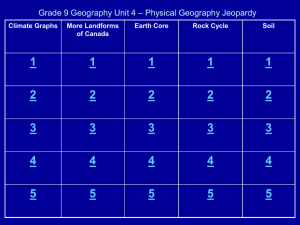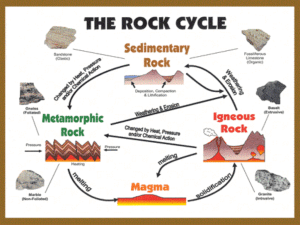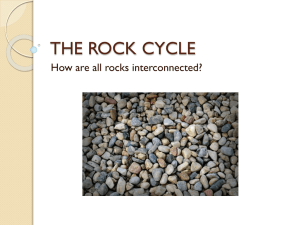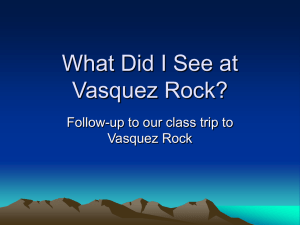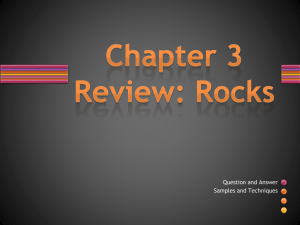Ch 6-Rocks - USD305.com
advertisement
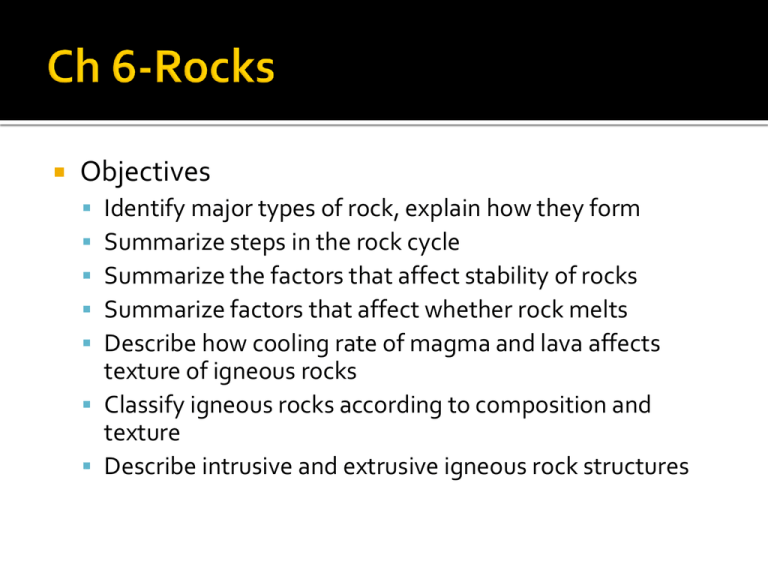
Objectives Identify major types of rock, explain how they form Summarize steps in the rock cycle Summarize the factors that affect stability of rocks Summarize factors that affect whether rock melts Describe how cooling rate of magma and lava affects texture of igneous rocks Classify igneous rocks according to composition and texture Describe intrusive and extrusive igneous rock structures Explain processes of compaction and cementation Describe how chemical and organic sedimentary rocks form Describe how clastic sedimentary rock forms Identify the sedimentary rock features Describe the process of metamorphism Explain the difference between regional and contact metamorphism Distinguish between foliated and nonfoliated metamorphic rocks, give example of each What defines a rock? Material that makes up solid parts of Earth, 1 or more minerals, or made of solid organic matter Types Igneous rock- forms from magma ▪ Means from fire Sedimentary-forms from sediment that is compressed and cemented together. How? Metamorphic-forms when existing rock is altered. How? ▪ Means changed from Rock cycle-series of processes in which rock forms, changes from one type to another, destroyed and forms again by geological processes Steps Igneous is exposed and broken into sediment Sediment is compacted and cemented Sedimentary rock becomes metamorphic through certain changes Metamorphic rock melts and forms magma New igneous rock Factors that affect stability Chemical Stability ▪ Chemical compound maintains stability or breaks down to form different chemical ▪ Depends on chemical bonds between atoms in mineral ▪ More bonds between silicon and oxygen=more resistant Physical Stability ▪ Rocks have natural zones of weakness, determined where rocks form What are igneous rocks? Rocks that form when magma cools and solidifies. Most are made of crystals How does magma form? What are the factors that affect whether a rock melts? Temperature, pressure, presence of fluid in rock Partial melting Intrusive igneous-rock formed from cooling and solidification of magma beneath Earth’s surface Extrusive igneous-rock that forms from the cooling and solidification of lava at Earth’s surface Differ in size of crystals or grains Texture determined by size of crystals in rock-size determined by cooling rate Coarse grained-large mineral grains Ex. Granite Slow loss of heat=large crystals Fined grained-small crystals Ex. Basalt and rhyolite Cools rapidly Porphyritic-large crystals embedded w/ small Cools slowly then more rapidly near surface Glassy-few crystals Ex. Obsidian Cools quickly, contains small % of dissolved gases Vesicular-full of holes Ex. Pumice Cools rapidly, contains large % of dissolved gases GRANITE-COARSE BASALT-FINE PUMICE-VESICULAR OBSIDIAN-GLASSY Composition-determined by chemical composition of magma Divided into 3 families; Felsic, mafic, intermediate Felsic Rock Magma contains a lot of silica Light coloring Contains plagioclase feldspar, biotite mica, muscovite mica Ex. Granite, rhyolite, obsidian, pumice M Mafic Rock Magma has lower proportions of silica Rich in iron and magnesium Contains plagioclase feldspar, pyroxene minerals. Also ferromganesian minerals-hornblende Ex. Basalt and gabbro Intermediate Rock Minerals such as plagioclase feldspar, hornblende, pyroxene, biotite mica Lower proportions of silica than felsic, higher than mafic Ex. Diorite and andesite What is an intrusion? Igneous rock masses that form underground Types of intrusive rock structures Batholiths-forms cores of mt ranges Stocks-similar to batholiths, smaller Laccoliths-form small dome shaped mts Sills-lies parallel to layers of rock around it Dikes-cut across rock layers. Common in areas of volcanic activity What are extrusions? Igneous rock masses that form on Earth’s surface Types of extrusions Volcano-vent in which magma, gases, volcanic ash are expelled ▪ Volcanic neck-solidified central vent ▪ Narrow dikes may be exposed Lava flows-flat masses of rock Lava plateau-series of lava flows that cover vast area w/ thick rock Tuff-volcanic ash deposits What is sediment? Loose fragments of rock, minerals, and organic material, result of natural processes Transported by wind, water or ice Sediment looses chemical and physical composition Compaction Sediment is squeezed, size of pore space between sediment grains is reduced by weight and pressure of overlying layers Cementation Sediments are glued together by minerals that are deposited by water Form from minerals once dissolved in water Form when dissolved minerals precipitate out of water because of changing concentrations of chemical Why do minerals precipitate? ▪ Evaporation Ex. Gypsum and halite Form from remains of living things Coal, limestone What makes up coal? What makes up limestone? Chalk Shells of tiny, one celled organism COAL-ANTHRACITE LIMESTONE Sedimentary rock that forms when fragments of pre-existing rocks are compacted or cemented together Types Conglomerate-rounded fragments Breccia-angular and have sharp corners Sandstone-sand sized grains cemented Shale-clay sized particles cemented and compacted together, easily split apart BRECCIA CONGLOMERATE SANDSTONE SHALE How are sediments transported? Characteristics of sedimentary rock Stratification-layering of rock, occurs when conditions of sediment deposition changes ▪ Beds=stratified layers ▪ Massive beds=no internal structures Cross beds-slanting layers of sed rock form w/in beds ▪ Sand dunes or river beds Graded bedding-various sizes and kinds of material in one layer ▪ Reverse grading=smallest grains on top of large grains Ripple Marks-caused by action of wind or water on sand Sandstone Mud Cracks-form when muddy deposits dry and shrink River’s flood plain, dry lake bed Fossils-remains or traces of ancient plants and animals Concretions-lumps of rock w/ different composition of main rock body Geode=rock that forms when minerals crystallize inside cavity of sed rock What is metamorphism? Process in which heat, pressure, or chemical processes change one type of rock to another Forms from existing igneous, sedimentary or metamorphic rock What causes minerals to change into other minerals? Types of metamorphism Regional and Contact Contact Metamorphism Change in texture, structure, chemical composition of rock due to contact w/ magma Regional Metamorphism Change in texture, structure, or chemical composition of rock due to changes in temperature and pressure over large area Tectonic forces Which way do you believe most metamorphic rock is formed? Classified on texture and chemical composition Types of Rocks Foliated-minerals arranged in planes or bands ▪ Extreme pressure causes crystals to realign or regrow ▪ Minerals w/ different compositions separate-dark and light bands Non-foliated-no bands or aligned minerals ▪ Original rock contains grains of only one mineral, or small amounts of other minerals ▪ Original may contain grains that are round or square ▪ Ex. Quartzite and marble GNEISS MARBLE QUARTZITE SLATE




